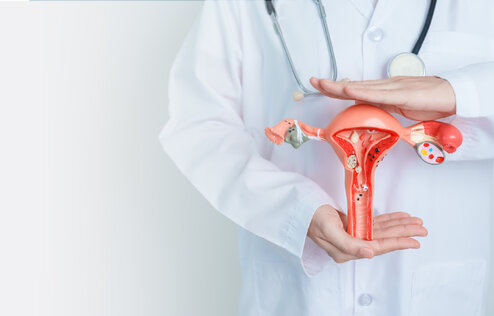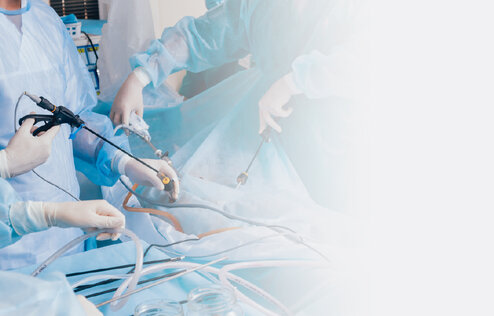Gynecological Laparoscopic Surgery
Center : Women Health Center
-01.jpg)
Table of Contents
- What is Gynecological Laparoscopic Surgery
- Why Should You Consider Gynecological Laparoscopic Surgery
- Gynecological Laparoscopic Surgery Types
- Diseases That Can be Treated with Gynecological Laparoscopic Surgery
- Advantages of Gynecological Laparoscopic Surgery
- Preparing for Gynecological Laparoscopic Surgery
- Gynecological Laparoscopic Surgery Procedure
- Recovery After Gynecological Laparoscopic Surgery
- Gynecological Laparoscopic Surgery Conclusion
- Why choose Nakornthon Hospital?
- Free Online Consultation with a Specialist
What is Gynecological Laparoscopic Surgery
Gynecologic laparoscopic surgery is a surgical procedure in which a laparoscope is inserted through the abdomen. The doctor uses a method to make a hole in the abdominal wall. Most are pierced at the navel in a hole only 0.5-1 cm wide to insert a telescope into the abdomen. The camera is used to transmit images of internal organs in the abdomen to view on a television screen. The doctor then drills another 2-3 holes, each 0.5-1 cm wide, in the abdominal wall to insert a special surgical instrument into the abdomen. To diagnose and treat gynecological diseases in the pelvic area, including the uterus, endometrium and ovaries, etc.
Why Should You Consider Gynecological Laparoscopic Surgery
Gynecologic laparoscopic surgery can be performed for both diagnosis and treatment.
- In the area of diagnosis, laparoscopic surgery can diagnose many symptoms. caused for any reason before surgery, such as
- Irregular light or very heavy menstrual periods.
- Having had two or more miscarriages.
- abnormal vaginal bleeding.
- suspected fibroids or polyps in the uterine cavity.
- Infertility diseases such as uterine fibroids pelvic fibrosis, inflammation.
- In terms of treatment, laparoscopic surgery can perform procedures to treat diseases or conditions such as
- infection of the pelvis.
- Endometrial hyperplasia
- Endometrial implants are implanted into the muscles of the uterine wall.
- uterine fibroid A lump that forms and grows inside the uterus. This can cause very irregular menstruation.
- pelvic prolapse because the uterus has descended into the vagina.
- Abnormal uterine bleeding.
Gynecological Laparoscopic Surgery Types
- Laparoscopic surgery is the use of an endoscope for diagnosis and perform intra-abdominal surgery.
- Hysteroscopic surgery in the uterus is the use of a camera to view abnormalities of the uterine cavity through the cervix for diagnosis. And performing surgery.
Diseases That Can be Treated with Gynecological Laparoscopic Surgery
- Myoma uteri
- Ovarian tumor
- Ovarian cyst
- Chocolate cyst
- Endometriosis grows in the wrong place. (Endometriosis)
- Pelvic adhesion
- Ectopic pregnancy
- Tubal obstruction (Tubal obstruction)
- Check the cause of infertility (Infertility)
- Tumors or polyps in the uterine cavity (Polyp, myoma).
- Uterine synechiae
- Septate uterus
- Female sterilization (Tubal Sterilization)
- Perforated IUD
- Hysterectomy for various causes (hysterectomy)
- Early stage of cervical cancer
- Early stage of Ovarian cancer
- Endometrial cancer
- Ovarian cyst tumors Non-cancerous types or large chocolate cysts, can be performed through small incision with laparoscopic surgery.
- A large myomectomy, which is solid tissue Laparoscopic surgery can be performed using a special instrument that cuts the biopsy into small pieces. Removed through a small incision and closed through the camera.

Advantages of Gynecological Laparoscopic Surgery
- Small surgical incision, about 0.5-1.0 cm in size, about 3-4 incisions
- Very little pain due to the trauma from surgery is less than traditional surgery
- Only stay in the hospital for 1-2 days
- Quick recovery and can return to work or daily activities in 5-10 days
- Reduce the chance of fibrosis from surgery
- Reduce the risk of complications from surgical wounds, such as inflammatory wounds, infected wounds, pus etc
However, in view of taking care of yourself after the laparoscopic surgery. You will be able to perform light activities within 3-5 days after surgery. But exercise should wait a month before surgery to ensure that you are completely healed.
Preparing for Gynecological Laparoscopic Surgery
- A blood test, chest x-ray, ultrasound scan, or electrocardiogram will be performed, as deemed appropriate by the physician to assess physical condition.
- Inform the doctor of any pre-existing conditions, such as congenital diseases or drug allergies.
- If you are taking medications, herbs or supplements Ask your doctor if it is necessary to refrain from taking any medications you are taking.
- Abstain from food about 8 hours before surgery or as directed by your doctor. You should eat soft, easily digestible foods before abstaining.
- Remove dentures, jewelry or valuables before entering the operating room.
Gynecological Laparoscopic Surgery Procedure
- The doctor drills another 2-3 holes, each 0.5-1 cm wide, in the abdominal wall to insert a special surgical instrument into the abdomen.
- Then perform the operation. and bring abnormal uterus or the diseased ovary comes out through the cavity in the abdominal wall.
Recovery After Gynecological Laparoscopic Surgery
After surgery there may be a minor complications, namely persistent shoulder pain. Pain due to the winds in the abdomen pressing on the diaphragm These symptoms can be relieved with painkillers and normalize within a day after surgery.
- Follow the doctor's instructions carefully.
- If the doctor allows eating, drink plenty of water and do not hold back urine.
- Get up and walk frequently to avoid abdominal fibrosis.
- If there is a problem or abnormality, consult a doctor or nurse.
- Come in for a physical exam and a post-surgery internal exam on the day and time the doctor specifies.
- Do not lift heavy objects and refrain from sexual intercourse for 1 month or as directed by the physician.
Gynecological Laparoscopic Surgery Conclusion
Currently, no less than 40,000 women have to undergo surgical intervention for gynecological diseases, because most gynecological diseases rarely have clear indications. Most women neglect them, not noticing them until they realize that their symptoms have already come to an end. Therefore, regular annual checkups help to detect these diseases. Gynecological laparoscopic procedures can diagnose and treat gynecological diseases. If they are detected early and treated quickly, the chances of a return to normality increase even more.
Why choose Nakornthon Hospital?
Nakornthon Hospital provides comprehensive health services to women of all ages from health check to diagnosis to prevent gynecological diseases. Diagnosis of gynecological laparoscopic surgery by specialists in each area. Consultation service with technology to help diagnose diseases to increase safety and efficiency of treatment with understanding, care for the health of all women.
For more information, please contact:
- - Website : https://en.nakornthon.com
- - Facebook : Nakornthon Hospital - International Patient
- - Line : @nakornthoninter
- - Tel: 02-450-9999 (Available 24 hours)
Free Online Consultation
Pacakages and Promotions
Article of Women Health Center






